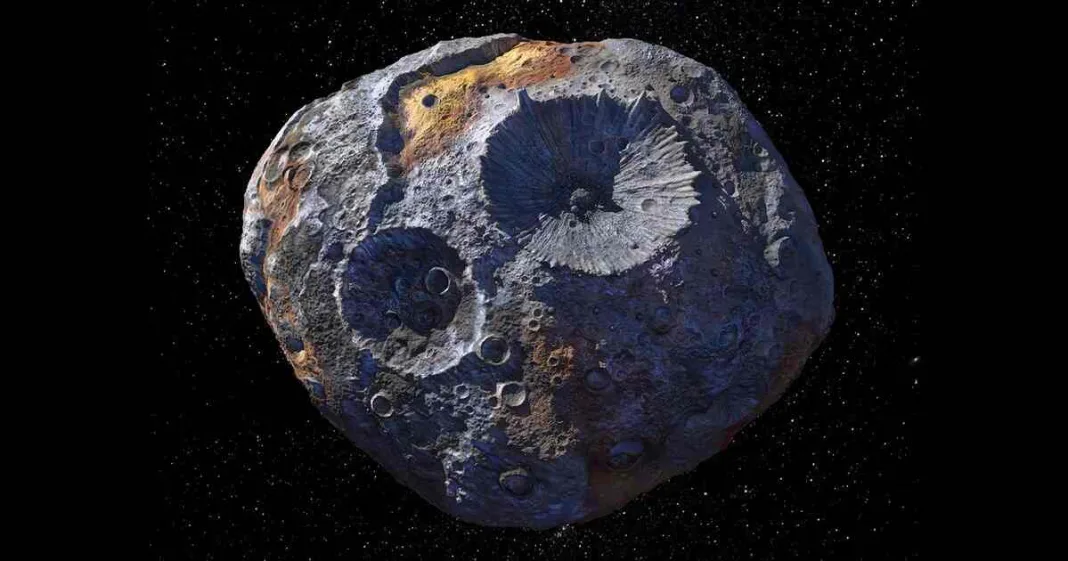A Southwest Research Institute-led team has made a groundbreaking discovery on the metallic asteroid Psyche using data from NASA’s James Webb Space Telescope (JWST). The detection of hydroxyl molecules on the asteroid’s surface suggests the presence of hydrated minerals, providing new insights into Psyche’s complex history. This discovery offers crucial context as NASA’s Psyche spacecraft, launched in October 2023, continues its journey to the asteroid, which orbits between Mars and Jupiter.
Psyche: A Unique Metallic Asteroid
Psyche, approximately 140 miles in diameter, is one of the most massive objects in the main asteroid belt. Believed to be a dense, largely metallic body, Psyche has intrigued scientists for years. Previous studies suggested that Psyche could be the exposed core of a planetesimal—a small celestial body that never developed into a full-fledged planet due to a catastrophic collision during the early solar system’s history.
Read More: NASA astronauts could be stuck in Space until 2025
However, the recent detection of hydrated minerals on Psyche’s surface challenges this hypothesis. Hydrated minerals typically form in the presence of water, implying that Psyche might have experienced a different evolutionary process than initially thought.
Hydroxyl Molecules and Their Implications
The Webb telescope’s data revealed the presence of hydroxyl molecules—an oxygen atom bound to a hydrogen atom—on Psyche’s surface. This finding indicates that Psyche has interacted with water at some point in its history. The key question now is whether the hydration is native to Psyche (endogenous) or the result of external impacts by other bodies, such as carbonaceous chondrite asteroids, which are known to be highly hydrated.
If the hydration is endogenous, it could mean that Psyche formed beyond the “snow line,” the region in the early solar system where temperatures were low enough for volatile compounds, including water, to condense into solids. This would suggest that Psyche might not be the remnant core of a protoplanet as previously thought, but rather an object with a more complex history that includes migration from a distant part of the solar system.
Complex Surface History
The Webb data also showed variability in the strength of hydration features across Psyche’s surface, suggesting a heterogeneous distribution of hydrated minerals. This uneven distribution points to a complex surface history, potentially shaped by multiple impacts from other asteroids. Such a history would have caused localized areas of Psyche’s surface to become hydrated, while other areas remained dry.
Understanding Psyche’s surface composition and history is vital not only for the Psyche mission but also for broader questions about solar system evolution. The asteroid’s metallic nature, combined with its hydrated minerals, makes it a key target for studying the distribution of water and other materials in the solar nebula—the cloud of gas and dust from which our solar system formed.
Implications for Solar System Evolution and the Search for Life
The discovery of hydrated minerals on Psyche has significant implications for our understanding of solar system evolution. Asteroids like Psyche are considered remnants of the planetary formation process, and their compositions vary depending on their formation location. Studying Psyche can provide insights into how materials in the solar nebula were distributed and evolved over time.
Moreover, the presence of water on Psyche—or on any other celestial body—raises important questions about the potential for life beyond Earth. Water is essential for life as we know it, and understanding its distribution in our solar system could guide future searches for life in other solar systems.
Read More: NASA’s Perseverance rover discovers potential signs of ancient life on Mars
NASA’s Psyche spacecraft is currently on its way to the asteroid, with an expected arrival in August 2029. The spacecraft will provide unprecedented close-up observations of Psyche, helping scientists to further unravel its mysteries. The mission, led by Arizona State University, aims to shed light on the asteroid’s composition, surface features, and history, offering valuable data that could reshape our understanding of planetary formation.













